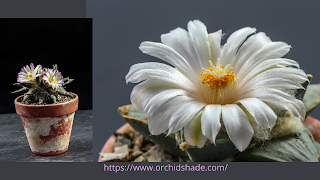Ariocarpus williamsii (Salm-Dyck) Voss
Family: CACTACEAE
Origin and Habitat: Grows in an area that stretches from the Chihuahuan Desert to the South Texas Plains, on either side of the middle and lower Rio Grande River, southward to the Mexican states of Chihuahua, Coahuila, Durango, Nuevo León, San Luis Potosí, Tamaulipas, Zacatecas. Extensive stands of peyote occur on the low, rocky hills in Starr, Zapata, Webb, and Jim Hogg counties of southern Texas.
Altitude: It grows from 100 up to 1900 meters above sea level.
Habitat and Ecology: This geophytic, button-like cactus occurs in xerophyllous scrub including Tamaulipan thorn scrub isolated or in groups usually in calcareous deserts, on rocky slopes, or in dried river beds. The species is very abundant in habitat with a large number of mature individuals however many subpopulations of Lophophora williamsii are heavily harvested in the wild throughout the range of the species, some to the point of extirpation. In Mexico, the collection is illegal and people are punished for collecting it. Land-use change for agriculture is a significant threat, as the land is completely plowed, thus eliminating all vegetation including L. williamsii and its seed bank.
Common Names include:
ENGLISH: Medicine of God, Devil’s root, Divine herb, Dry whiskey, Cactus pudding, Devil's-root, Diabolic-root, Divine cactus, Dry-whiskey, Dumpling cactus, Indian-dope, Mescal-buttons, Turnip cactus, Peyote, Pellote, Mescal Buttons, Whiskey cactus, White-mule
Cultivation and Propagation: All Lophophora species are extremely slow-growing, often taking up to thirty years to reach flowering age in the wild (about the size of a golf ball, not including its root). Human cultivated specimens grow considerably faster, usually taking from six to ten years to go from seedling to mature flowering adult.
Because the taproot is very rotted prone, so use highly gritty compost with much drainage. Requires half shade to part sun. Waterings should be rather infrequent to keep the plant compact and not to become excessively elongated and unnatural in appearance, watering it properly is often difficult because this plant tends to crack open or rot if over-watered. The fact that the plant retracts into the soil and assumes a grey-green coloring between watering, is perfectly natural and doesn’t cause any damage.
Overwatering: Keep completely dry and cool in winter (An unheated greenhouse would be perfect) or when night temperatures remain below 10° C, it can survive low temperatures (appr. -7°C) for a short period. Assure good ventilation.
Propagation: Easy to propagate from seeds. The seeds are, requiring hot and humid conditions to germinate.
The soil mix that I use for sowing Ariocarpus is my standard germination mix for cactus seed: two parts peat-based commercial potting-soil, one part loam, one part leaf mold, one part marble grit or coarse sand, and one part perlite. The mix is moistened and baked for two hours. For sowing up to 20 seeds I use 5.5 cm diameter by 5 cm deep pots, for larger quantities, I use either multiple small pots or larger containers 12 x 8 x 5 cm for up to 200 seeds. The seeds are dispersed on a thin layer of sowing mix mixed with grit (1:1) and should be covered to a depth that equals their diameter. After sowing the seed the pots are soaked in a bath of distilled or boiled water with fungicide (chinosol) and covered with thin plastic.
Uses: Peyote has been used for centuries for the mystical effects experienced when it is ingested. It contains a large spectrum of phenethylamine alkaloids, the principal of which is mescaline. The top of the cactus that grows above ground also referred to as the crown, consists of disc-shaped buttons that are cut from the roots and dried. These buttons are generally chewed, or boiled in water to produce a psychoactive tea. The resulting infusion is extremely bitter and, in most cases, the user experiences a high degree of nausea before the onset of the psychedelic effects.
However cultivated plants have only traces of the alkaloid present in wild-harvested plant and their “psychedelic” effect are minimal or completely absent, but they still cause nausea, vomit, headache.
Myths and Truths
The genus Ariocarpus has been the subject of much affection and attention by growers and botanists, but also has been surrounded by many myths that persist to date which I would like to challenge from the very beginning.
1. Contrary to popular belief ariocarpi do not present any special problems in cultivation. Granted, these plants require a little more attention (or rather neglect) than your average cactus but there are many others far more difficult to grow. An Ariocarpus, if cared for properly, will grow steadily and flower reliably.
2. Cultural advice like "grow in full sun" and "give at least two hefty waterings in the growing season" (Needham, 1983) may very well explain the descriptive term "living fossils" often applied to Ariocarpus plants. In my Mediterranean climate, Ariocarpus certainly appreciate some shading and require as much water as all other cacti, especially if grown in clay pots.
3. "Ariocarpi are the slowest growing cacti". Well, they are particularly slow in childhood, but a 10 cm (4 inch) A. retusus can be grown in about five years, which beats many other cacti. If you want to experience "slow" try some Aztekium from seed.
4. "The minimum time to grow from seed to flowering size is probably ten years, and may well be twice that" (Weightman, 1991). Actually, A. agavoides will eagerly flower at three years from seed (Fig. 2) and most species will flower by the age of five or six years..
5. "Ariocarpus seedlings are exceptionally prone to rot." In my experience this is not true, in fact, I have come to realize that Ariocarpus seedlings benefit, more so than other cacti seedlings, from a humid closed environment during their first year of growth. This was actually the cornerstone in developing a reliable method for raising Ariocarpus from seed.
Sources: Living-rocks














.png)
0 Comments